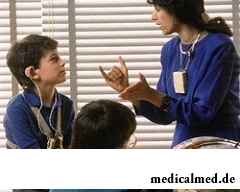





Deafness
Deafness is such hearing disorder at which the person cannot hear in general, or degree of a hearing impairment is so strong that perception of sounds of the speech becomes impossible.
Hearing physiology
 The acoustic organ consists of the sound carrying out and sound perceiving parts. Each its component in the course of evolution is adapted for the best performance of the tasks. For example, the shape of an auricle of the person allows to catch better sounds, and acoustical pass improves quality of carrying out a sound.
The acoustic organ consists of the sound carrying out and sound perceiving parts. Each its component in the course of evolution is adapted for the best performance of the tasks. For example, the shape of an auricle of the person allows to catch better sounds, and acoustical pass improves quality of carrying out a sound.
In a structure of the acoustic analyzer it is possible to allocate:
- Outside ear (auricle, outside acoustical pass);
- Middle ear (tympanic membrane, acoustical stones, drum cavity);
- Inner ear (snail, semicircular channels, кортиев body);
- Receptors;
- Conduction paths;
- Cortical department in a brain.
Sounds which we hear are mechanical oscillations of airspace. They cause fluctuations of a tympanic membrane in an inner ear which resonates them with own frequency. Further transfer of fluctuations is carried out by means of acoustical stones (a hammer, an anvil and a stirrup) and liquid (endolymph) in a labyrinth of an inner ear. The hairs of a kortiyev of body which are in this liquid (in fact they are sensory cells) turn oscillatory mechanical waves into acoustical nervous impulse which further on nerve fibrils is transferred in a brain.
Deafness reasons
Now it is authentically known that reasons of deafness there can be a set.
Hearing disorder can arise from constant noise at work (a so-called, noise injury), after the postponed otitis (an ear inflammation), meningitis (an inflammation of a meninx) or toxic influence on an acoustical nerve of antibiotics from group of aminoglycosides. Scarlet fever, respiratory viral and some other infectious diseases can become the reason of deafness. The injury of a temporal bone can cause disturbance of a structure of an acoustic organ or integrity of an acoustical nerve and, as a result of it is deafness.
Types of deafness
Completely hearing is absent quite seldom. Much situations when residual audibility remains meet more often, and the person is capable to distinguish very loud speech or some of its frequencies. These states are called relative deafness. Accurately it is difficult to differentiate definitions of relative deafness and deafness, and it depends on a research method.
If the person lost hearing still before learned to speak, then he can remain a deaf-mute.
By origin allocate the following types of deafness:
- Hereditary (passes from father to son, it is connected with chromosomal disturbances);
- Inborn (appeared at an adverse effect on a fruit during its pre-natal development or at the time of delivery);
- Acquired (as a result of age changes of an acoustic organ, diseases, injuries, toxic influence of some medicines, etc.).
In the place of damage of the acoustic analyzer allocate neurosensory and conductive deafness. Neurosensory deafness arises if formation of acoustical impulses, their carrying out or perception in a brain is broken. Disturbances of functions of the carrying-out device of the acoustic analyzer (are the reason of deafness of conductive type at ear injuries, an otosclerosis, etc.).
Deafness is also classified by extent of decrease in hearing.
Inborn deafness
The hearing organogeny at an embryo begins with the 5th week of the pre-natal period. On the 20th week of pregnancy future child already has an inner ear, on maturity degree comparable with the adult. Since the same time the kid in a maternal womb begins to distinguish sounds of different intensity and frequency.
Inborn deafness develops because of pathological influence of some factors on a fruit and damages of components of the acoustic analyzer. Extent of decrease in hearing as a result can widely vary – from full deafness (occurs at 0,25% of newborns) before its insignificant decrease.
Among the reasons of inborn deafness most often note infections (generally viral, for example, measles, a rubella, flu), toxic influence of medicines which are accepted by mother during pregnancy (streptocides, aminoglikozidny antibiotics and others). In emergence of a number of cases of inborn deafness toxic influence of alcohol is scientifically proved.
Detection of deafness
The doctor-audiologist deals with problems of a hearing disorder though at first patients most likely will ask for the help the otolaryngologist.
Deafness can develop suddenly or gradually, is quite imperceptible for the person. Complaints to deafness demand carrying out additional methods of inspection. Modern techniques and the exact equipment allow to estimate objectively degree of deafness and the remains of hearing.
Hearing disorder has to be revealed as soon as possible after the birth because the level of development of the child and extent of his adaptation, and also a possibility of recovery of the hearing aid depends on it.
Already in the neonatality period in many maternity hospitals the screening research is conducted by special audiometers of acoustical function of all children. Audioscreening is carried out before an extract from maternity hospital by specially trained employee. It is bystry, painless and absolutely safe method of detection of inborn deafness. At adults carrying out perhaps audiometriya the speech.
Treatment of deafness
Hearing to a large extent influences quality of human life therefore at incomplete deafness its correction using the hearing aids strengthening sounds is possible. It is so-called electro-acoustic correction.
 Medicamentous methods of treatment of deafness are ineffective, the plastics or endoprosthesis replacement most often is required.
Medicamentous methods of treatment of deafness are ineffective, the plastics or endoprosthesis replacement most often is required.
Recently in treatment of deafness hearing aid using the special electrodes implanted in an inner ear (cochlear implantation) is used. Intensively the surgery of an inner ear develops at the microscopic level (a tympanoplasty, a stapedoplasty, etc.).
Corrections give in most often conductive types of deafness.
In the aspiration to pull out the patient, doctors often go too far. So, for example, a certain Charles Janszen during the period from 1954 to 1994 endured more than 900 operations on removal of new growths.

Impossibility to conceive the child – a trouble of many Russian families. During quite long time was considered that the main "culprits...
Section: Articles about health
Venereal diseases in medicine are called the infections which are transmitted preferential sexually, now they and are called - infections, sexually transmitted, or STD. Among them is also life-threatening. In spite of the fact that majority...
Section: Articles about health
A lot of things depend on a condition of a backbone in a human body, a backbone - not only a support for a body, it also a receptacle for a spinal cord, that is why malfunctions with a backbone are so dangerous. To treat rachis diseases very difficult and long, it is much simpler and more correct not to bring to a disease. Conforming to the rules provided in this article it is possible to avoid the majority of the problems connected with a backbone including those which are considered to be age, but a cat...
Section: Articles about health
(Xerostomia) many people consider feeling of a xerostomia small and easily removable inconvenience. This delusion...
Section: Articles about health
Health and attractiveness - eternal values, pursuing which people often use the most unusual ingredients and technicians. Let's consider 11 most exotic and sometimes not most pleasant Spa procedures to which the person in a pursuit for beauty agrees...
Section: Articles about health
In consciousness of our many compatriots idea that folk remedies if are no more effective, than medicinal "chemistry" strongly took roots, then are precisely less harmful. Unfortunately, it is not always fair: some methods of treatment consecrated with "century national experience" can work so on the patient that it will need urgent intervention of physicians....
Section: Articles about health
Quite large number of people adheres to the principles of vegetarian food. But how to be if in a family of vegetarians is д...
Section: Articles about health
Practice of hypnotic impact on consciousness of the person contains about two millennia. During this time scientists managed to learn a lot of things about a phenomenon of hypnosis and learned to facilitate a condition of the patients having heavy illnesses with its help....
Section: Articles about health
Many parents of children at the age of 2-4 years face excessively whimsical behavior of the child. The kid exhausts constant crying and whims not only the parents, but also himself. In what the reasons of children's whims. And how to fight with them?...
Section: Slideshow
Separate food - the system of meal based on digestion physiology which is carried to improvement methods. In opinion д...
Section: Articles about health
The dietology, as well as other sciences, does not stand still. Food stuffs are exposed to comprehensive study, and scientists obtain new information on their properties and influence on a human body. Unfortunately, this reasonable and natural process from time to time д...
Section: Articles about health
The phenomenon of improvement of a condition of the patients at administration of drugs who are not containing active agents, so-called effect of placebo is known long ago. At the end of the 18th century the American doctor Perkins began to treat people the "miracle" sticks made of alloy of steel and brass. Was for several minutes to press such subject enough to a sore point that it became much easier for the patient. Having suspected Perkins of charlatanism, his colleagues tried to repeat "miracle" by means of sticks, steles...
Section: Articles about health
All of us, unfortunately, should face flu nearly an every year. It would seem, so frequent disease has to be study...
Section: Articles about health
When overcomes feeling of hunger, and an opportunity to have dinner fully is absent, having a snack − the meals, small on volume, stabilizing sugar level in blood comes to the rescue. The relation of nutritionists to having a snack is more often negative, but only because in кач...
Section: Articles about health
Cold is such painful that each sigh becomes a victory, heat "knocks" down, and the ache in joints forces to think only of pain. Some people with approach of the first symptoms of cold make the self-sacrificing decision to have a disease standing, and at best to rest in bed with a cup of hot tea. There is an opinion that if not to treat cold, then the organism itself, sooner or later, will overcome an illness. Whether so it? It is known that if in time it is simple not to begin treatment, apparently, harmless...
Section: Articles about health
Antibiotics - - it is possible to call the chemical compounds suppressing growth of bacteria the break in the field of medicine which allowed to save persons...
Section: Articles about health
Ayurveda - the most ancient tselitelsky practice which came to us from India. It represents the doctrine about maintenance of physical, psychological and moral health of the person by means of the complex of procedures including a diet, cleaning of an organism, respiratory упр...
Section: Articles about health
Scientists have no unambiguous opinion on a proximate cause of emergence of a carcinoma cutaneum today. Only the factors promoting development of this illness are precisely established. Treat them: long impact on skin of ultraviolet rays, radiation exposure, thermal injuries, injuries of skin by aggressive chemicals (pitches, acids, alkalis, etc.), genetic predisposition (existence of malignant new growths of skin in the family anamnesis), at...
Section: Articles about health
Tick-borne encephalitis – one of the most dangerous viral diseases which causative agents transfer and is given to people by ixodic mites. Эт...
Section: Articles about health
Summer in the heat. Many are going to spend vacation abroad. Travelers the tender seas, rest on beaches wait, for sightseeing, campaigns on natural and cultural reserves. But, unfortunately, on vacation also problems about health can wait for us...
Section: Articles about health
Diapers for adults – individual one-time means of hygiene which in some situations is irreplaceable and from such situations any person is not insured. Though nobody perceives need of their use with enthusiasm, however without such means already problematic situation could be heavier....
Section: Articles about health
Tuberculosis – a serious infectious disease which development is caused by mycobacteria (Koch's bacilli). The illness is known from a deep d...
Section: Articles about health
Contrary to popular belief, the multiple sclerosis (MS) is not connected neither with sclerous changes of walls of vessels, nor with age forgetfulness and problems with concentration of attention. This disease has the autoimmune nature. Pathological process of a vyrazh...
Section: Articles about health
Heart disease and blood vessels lead to disturbance of blood supply of bodies and fabrics that involves failures in their work, deterioration in health of the person, decrease in its working capacity and standard of living. Annually more than 17 million inhabitants of our planet perish from pathologies such....
Section: Articles about health
Nightmares belong to the most unpleasant frustration. Statistically, they happen at 4% of adults, and almost at 70% of children and...
Section: Articles about health
The state of health of the person in many respects depends on chemical composition of biological liquids of an organism. Specialists consider that PH value of these solutions has to be in range of 7,35-7, 45. A deviation in the smaller party (so-called "acidulation") to a chra...
Section: Articles about health
The climax, or menopause is the normal process of the termination of genital function of the woman which is followed by serious hormonal changes in an organism. Usually the menopause begins at the age of 50-55 years, but characteristics of this process are very individual. Factors of earlier approach of a climax are irregular sex life, numerous abortions, addictions, existence of endocrine, autoimmune and gynecologic diseases, frequent stresses and excessive hobby of diets...
Section: Articles about health
